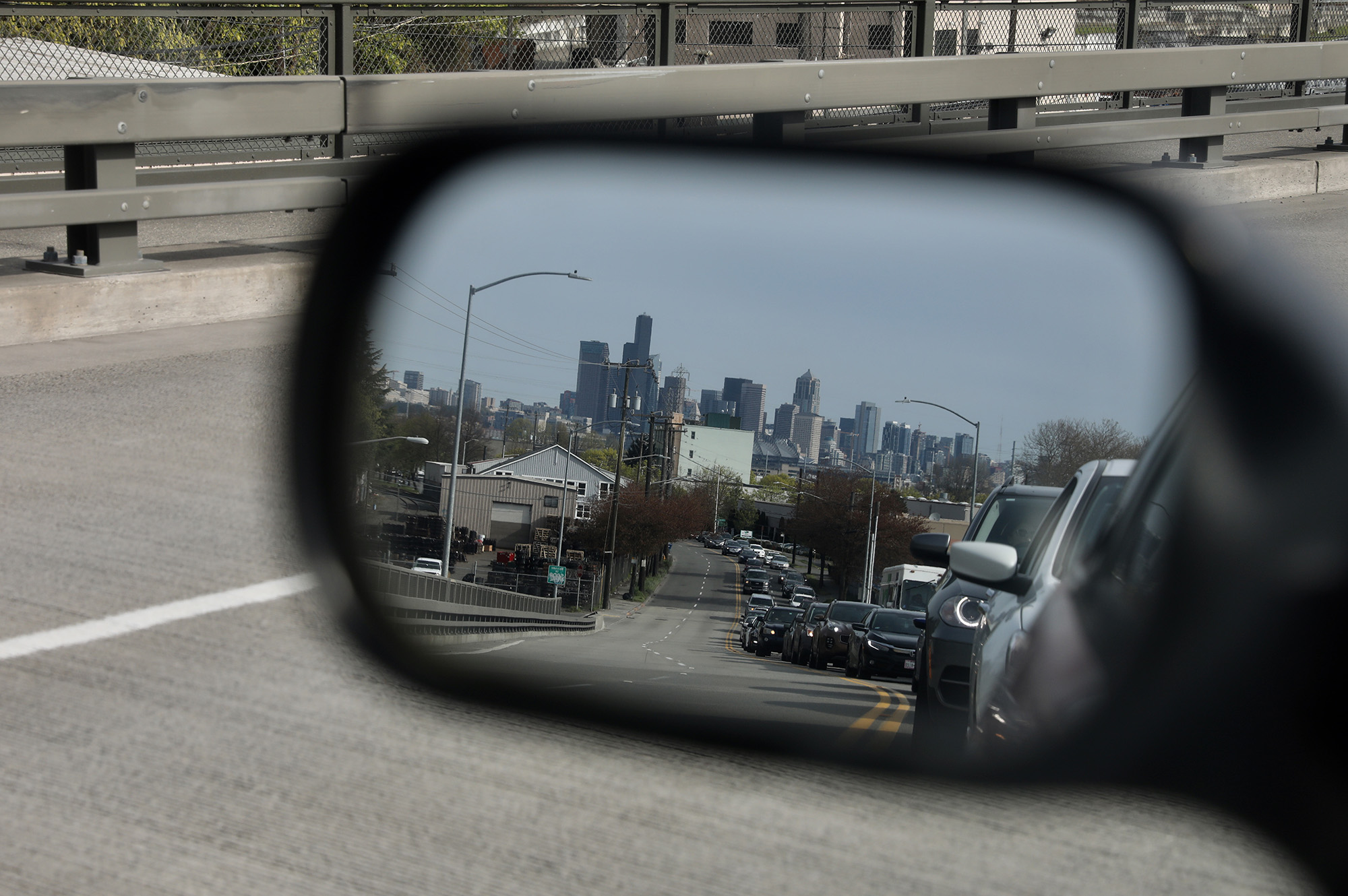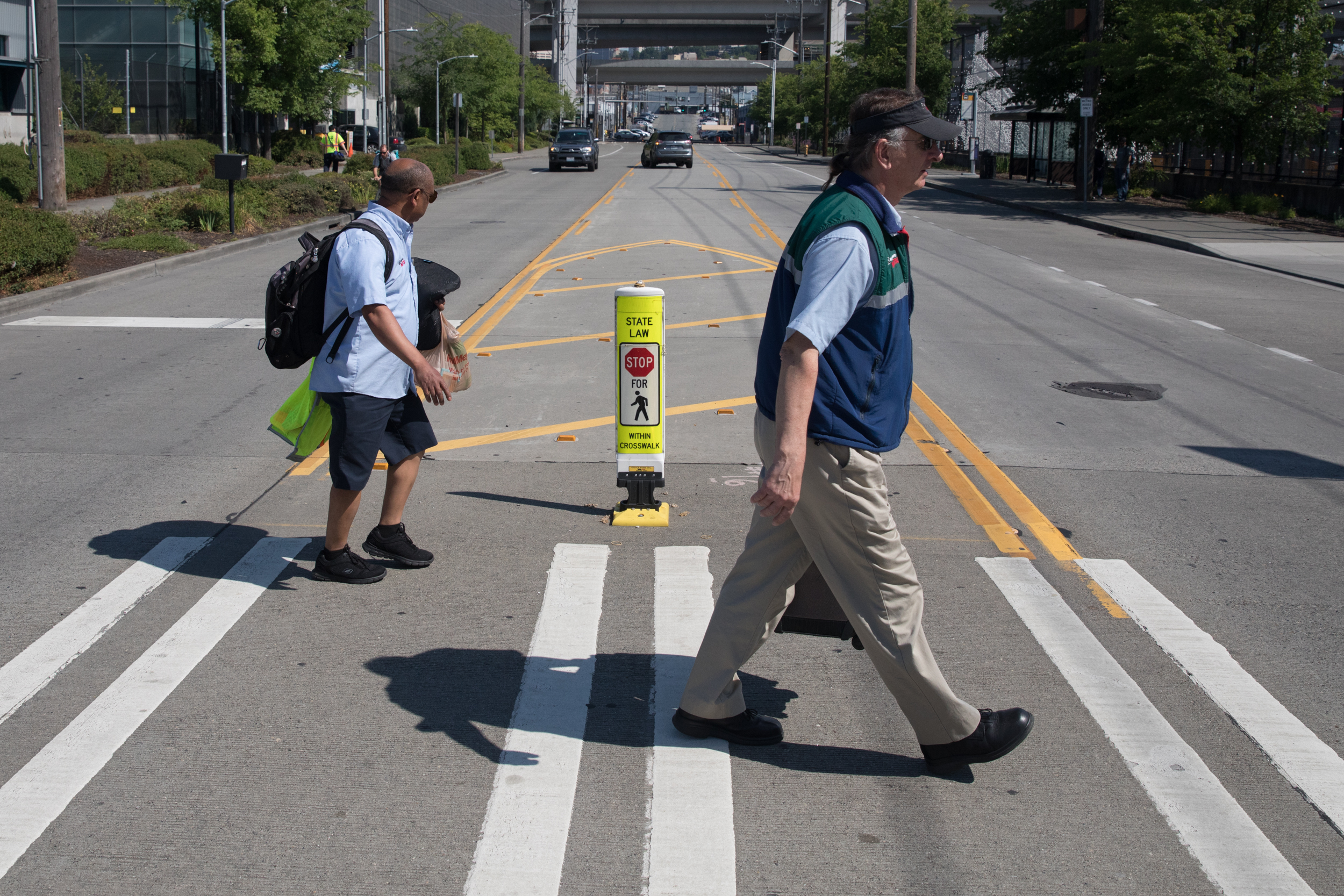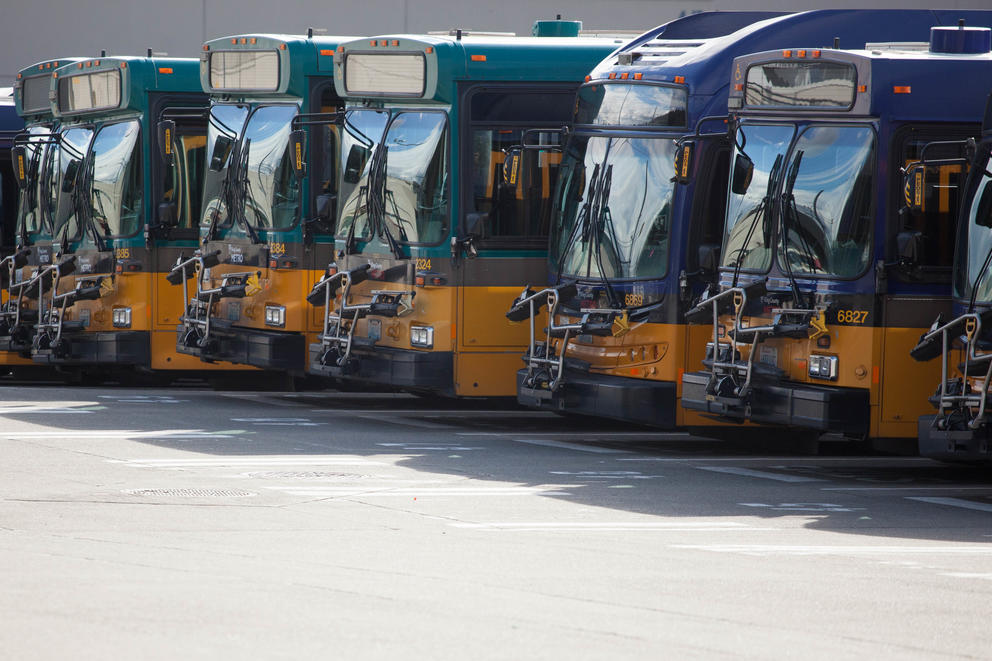SDOT officials said the proposed project, in which they’d hire private shuttle services to supplement Metro buses, could reduce driving in the center city, helping them meet their goal of 3,000 fewer cars a day. Such a result would have continued a trend that has seen the number of solo drivers commuting downtown drop by 4,500 from 2010 to 2017, while the number of transit riders increased by 41,500 in that time.
It could have also mitigated the impact of the Seattle Convention Center expansion, which will kick all King County Metro buses out of the downtown transit tunnel and onto surface streets by March 2019. Other major construction projects will further jam up downtown through 2021, a stretch that the city refers to euphemistically as the “period of maximum constraint.”
Opponents worried that private contracting could undercut Metro workers’ wages and lead to a two-tiered transit system for the rich and poor. Ultimately those concerns won over the council.
But the traffic problem is growing and the city needs a solution, even if it’s not going to be with private transit experiments. One idea – supported by advocates, bus drivers and some councilmembers – is to invest deeply to improve the bus system we already have. Mayor Jenny Durkan has floated a tax on private vehicles to discourage driving downtown. Seattle’s eastside neighbors think self-driving vehicles could solve their problems. Bike advocates remind us that bikes take up far less space than cars and could help, if only we make downtown a safe place to ride.
About those private buses
SDOT’s $5 million pilot project would have contracted with private companies to operate 8- to 15- passenger vehicles on routes passing through the center city that have high rates of solo driving. Early drafts proposed routes from Wedgewood, Crown Hill, Ballard and Alki to job centers such as First Hill and South Lake Union. Getting from start to finish on those trips often requires transferring buses downtown, which makes transit far slower than driving.
Such private-public agreements are not uncommon. Los Angeles, Austin, Texas and New Orleans all use private contracting to varying degrees of success, says David Bragdon, executive director at Transit Center, a New York-based transit research foundation. Bragdon says that opponents of the project are correct: in some cases, private contracting can lead to degraded working conditions and service quality. But the opposite can be true as well, he says, if cities set clear expectations. “Contracting done well can be effective. It can be good for customers, it can be good for the workforce. If it’s done badly you get worse service and spend more in the long run. Too often it’s done at the expense of the workforce.”
Bragdon does see one other potential issue with the now-scuttled plan: the size of the supplemental vehicles. He says, “Probably the biggest challenge and opportunity [in Seattle] is that the existing high density, high ridership buses are already crowded. Adding more large vehicles and greater frequency is probably going to get you better results in terms of more people, than running small, less efficient vehicles.”
SDOT’s proposal is off the table now, but Transit Center expects more cities to turn to private transit contracting in the future, not less, so Seattle may someday see a return of the idea.
Making buses work better
When faced with the possibility of a partnership with private contractors, public transit advocates said that they would rather see the city focus on doing everything it can to make existing bus service work better.
“I’m asking (SDOT) to do the things they’re good at,” said Metro driver Phillip Blake at last Monday’s city council meeting. “Provide bus lanes, provide bus signals, provide ways for buses to move about the city faster than automobiles. Maybe that will encourage people to take the bus rather than their car.”
Some of the same suggestions presented by Blake are included in the One Center City plan – a joint effort by the city, King County, Sound Transit and the Downtown Seattle Association to address downtown traffic. It includes additional bus lanes, bus signals and all-door boarding, as well as new bike lanes, pedestrian safety improvements and carpooling campaigns. Not all of the ideas are funded, but SDOT is going to extend the existing bus-only lane on 5th Avenue several blocks and add a bus lane to 6th Avenue to improve downtown bus service. On 3rd Avenue, they will extend the weekday car-free zone north to Denny, extend the bus-only time from morning to night on weekdays and implement all-door boarding.
There’s some evidence that these moves could work. According to a report from the Victoria Transport Policy Institute, bus-only lanes can more than double travel speed for buses (versus driving in mixed-traffic), making them more attractive than congested driving. A 10 percent travel time improvement leads to a 4-6 percent increase in ridership. When coupled with other improvements such as priority signaling for buses (where buses get a head start over cars at red lights), and all-door boarding (where passengers can get on at any door, as they currently do on RapidRide lines) the ridership increases are even larger.
Of course, making Seattle buses more attractive will only have so much impact since Metro cannot provide more buses to meet the weekday afternoon and evening demand when buses often fill to standing-room only. Metro’s most recent system evaluation report found that 13 routes have “chronic overcrowding” – the kind that leads to full buses passing stops without picking anyone up.
Still, Metro can’t absorb significantly more riders in Seattle without adding buses and the agency cannot add more buses to its fleet without building more operating bases since the current bases are already over capacity. Similarly, Metro has been unable to hire drivers fast enough to meet demand. They currently have about 3,000 full- and part-time, the most they’ve ever had according to Metro spokesman Jeff Switzer. Metro is working on building a new base and is constantly hiring, but meeting the city’s demand will take time.
Even if Seattle can’t get more buses on the road any time soon, faster bus travel times would mean the existing buses could serve more people in the same amount of time. Councilmember Mike O’Brien pointed out that after the 44 bus route got curb bulbs, signal prioritization and other improvements to speed it up, it had, “the same effect as buying more service hours because buses can complete their routes in shorter time and make more trips with the same buses and operators.”

Taxing cars off the road
In April, Durkan directed SDOT to begin studying downtown congestion pricing, a toll that would impact drivers entering a certain zone in the city, typically the downtown core on weekdays or during rush hour periods. If Durkan follows through, Seattle will be the first city in the United States to implement a congestion charge. The mayor’s interest in congestion pricing is mostly about the environment (two-thirds of Seattle’s greenhouse gas emissions come from transportation), but some of the cities around the world that have implemented the toll have seen significant reductions in the number of daily drivers.
Introduced in 2003, London’s congestion charge is one of the best known examples in the world. Between 2003 and 2014, the number of private vehicles entering central London dropped 39 percent. Some of its success has been offset in recent years by the rise of private ride-hailing services such as Uber, however, as drivers clog the streets picking up and dropping off customers. Stockholm uses variable pricing – charging more to drive downtown at rush hour than off-peak hours. Since implementing it in 2007, they’ve seen a 20 percent reduction in traffic volumes. Oslo is taking things many steps further with plans to flat out ban private cars in the central city by 2019.
There are no details yet on Seattle’s congestion pricing might look like, but Durkan says she’s hoping to have something in place before the end of her first term in 2021.
The rise of the robot cars
Earlier this month, the Seattle Times reported that Bellevue and Kirkland are planning to pilot autonomous shuttle vehicles. To start, the cities hope to run 11-passenger shuttles on a one- or two-mile loop of downtown, maybe as soon as this fall. Longer term, the vision is to have the shuttles drive people between the cities and suburban communities not served directly by Metro or Sound Transit. Their hope is that as more businesses set up shop in their city, workers won’t have to rely on personal vehicles to get them to and from work.
That idea – that individuals will use shared self-driving vehicles – is the utopian vision for the technology. In that future, the increased efficiency of autonomous vehicles not prone to human error will outweigh people’s desire to have a private vehicle ready and waiting at all times. The dystopian version of our self-driving vehicle future is that everyone continues to own personal cars and our streets will continue to be a gridlocked mess, but people will have a higher tolerance because they’ll sit back in their personal, air conditioned bubble browsing the internet while their car does the work of inching through traffic.
The eastside cities are not alone in their interest in robot cars. Governor Jay Inslee recently signed an executive order allowing self-driving vehicles tests on Washington roads. The Washington State Legislature created an autonomous vehicle working group this year to study the technology and begin hashing out policy ideas for regulating it. Waymo, Uber, Ford and other companies are already testing self-driving cars on private lots and public streets in the Bay Area, Phoenix, Pittsburgh and Ypsilanti, Michigan.
Bringing on the bikes
Seattle isn’t a great bike town. The city has the reputation of one because of its early investments in bike lanes and because it’s consistently ranked in the top 10 of U.S. cities with the most bike commuters. But Seattle’s bike network is still largely piecemeal. There are some protected bike lanes – the kind separated from car traffic by bollards or curbs instead of just painted lines – such as the one on 2nd Ave, Westlake, and Broadway through Capitol Hill. But there are often gaps between the starts and ends of Seattle’s bike infrastructure, meaning if you’re the kind of person comfortable riding in a good bike lane, but not comfortable fending for yourself on a street without bike lanes, you’re probably not going to ride in Seattle.
Cascade Bicycle Club and other advocates have long called for the city to build a connected network in the center city, with protected bike lanes on several north-south and east-west corridors to ensure anyone can get to, from and around downtown safely. A 2016 study by the National Association of City Transportation Planners found a strong correlation between number of bike lanes and number of bike riders. Ridership on Seattle’s 2nd Avenue protected bike lane has grown. In the first three months of 2018, weekday daily ridership was up 38 percent over the same period the previous year, which SDOT says is in part thanks to the popularity of dockless bikeshare bikes. It is likely ridership would grow even further with a more robust collection of bike lanes, but Cascade’s vision of a connected network isn’t coming anytime soon.
The One Center City plan was supposed to help create that basic bike network. Early versions of it had plans for a protected bike lane on 4th Avenue, a recognition that bikes could be part of the downtown congestion solution. It also calls for extending the 2nd Avenue protected bike lane south to Dearborn and on Pike and Pine up to Broadway. Durkan put the 4th Avenue plans on hold, however, a move Cascade said is part of a, “pattern of delays to building the downtown protected bike network” and implementing the Bicycle Master Plan.

It’s likely that the real solution for Seattle’s traffic woes lays in some combination of all of the above. SDOT saw private cars as just one tool among many they’d need to get 3,000 solo drivers out of their cars. The One Center City Plan takes a many-pronged approach.
It’s possible too that there’s some unknown solution coming down the line. The rainbow of bikeshare bikes on Seattle’s streets hasn’t singlehandedly transformed traffic (and has plenty of its own problems). But its surprise, nearly-overnight popularity is evidence that future traffic solutions might come from unexpected places.


